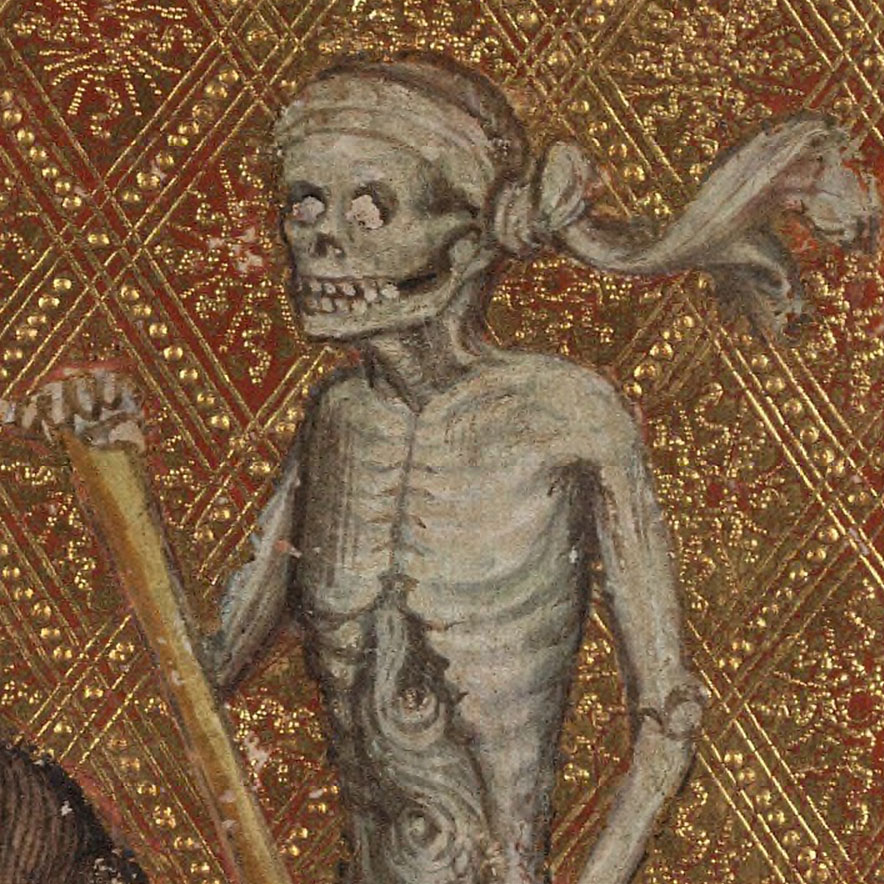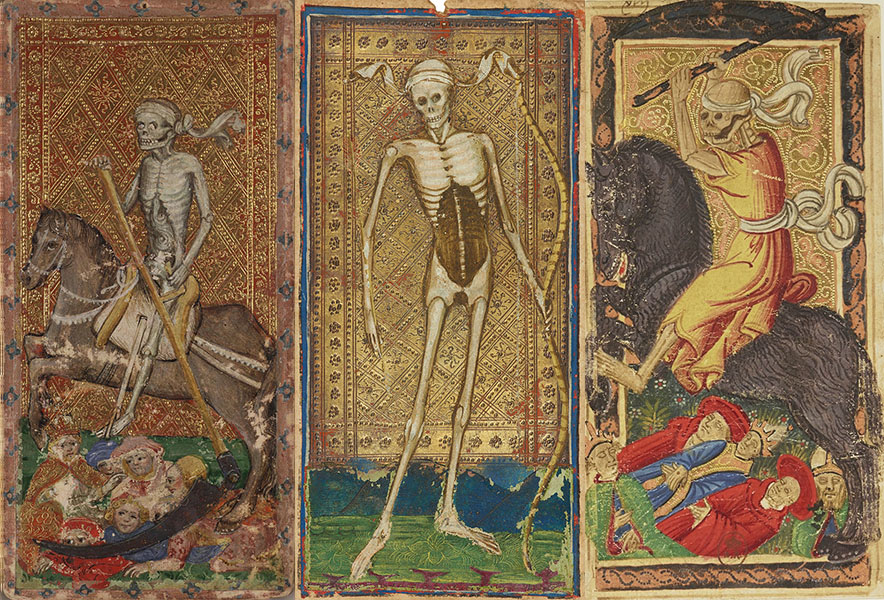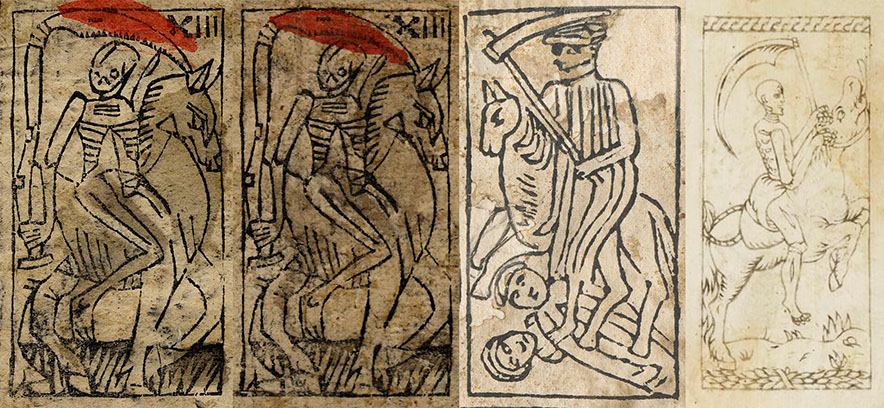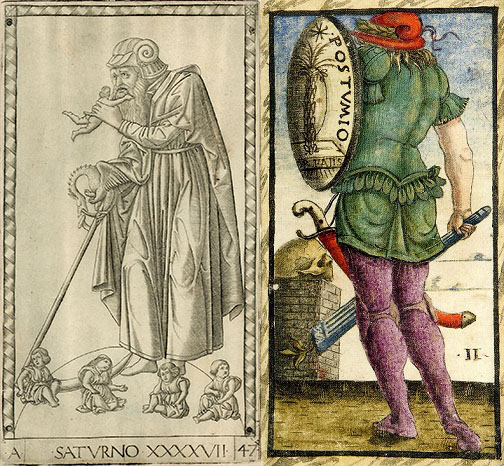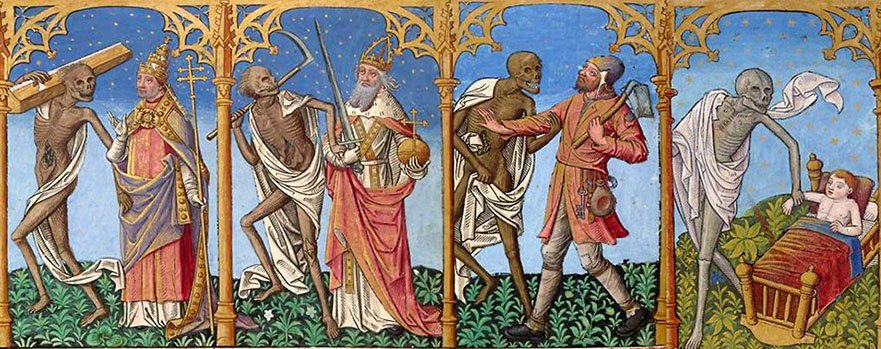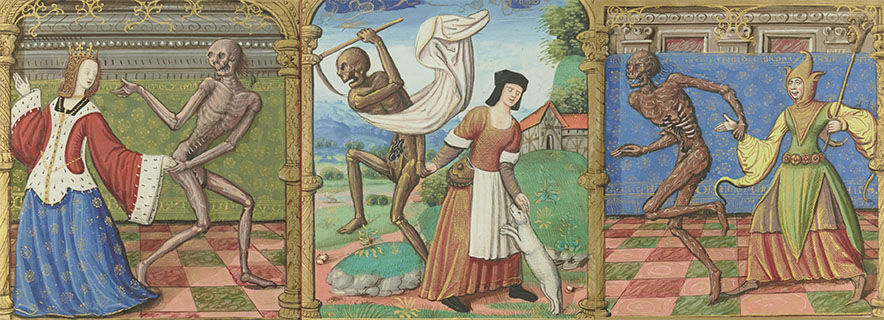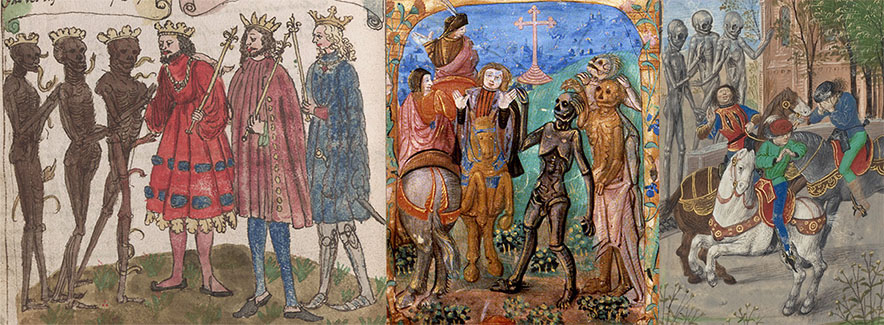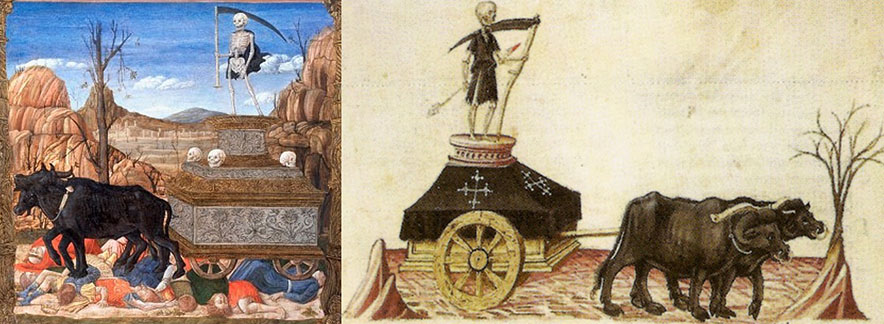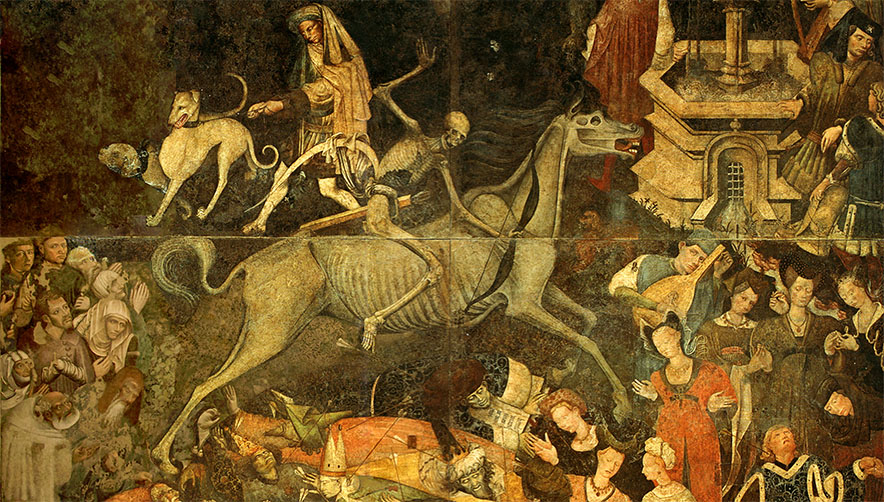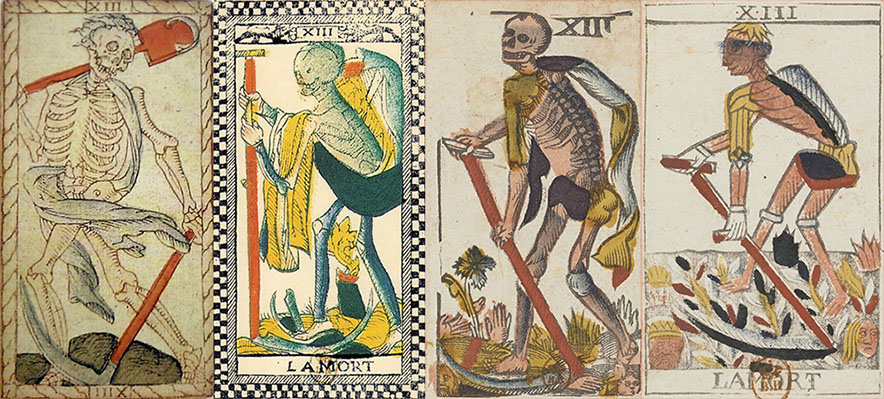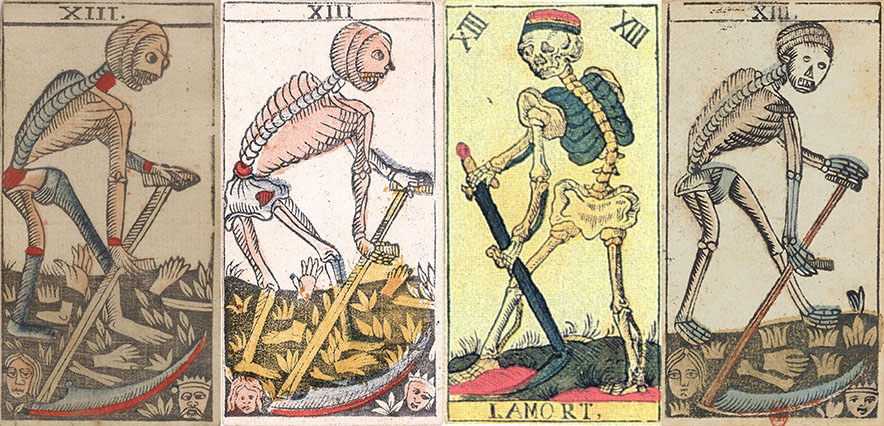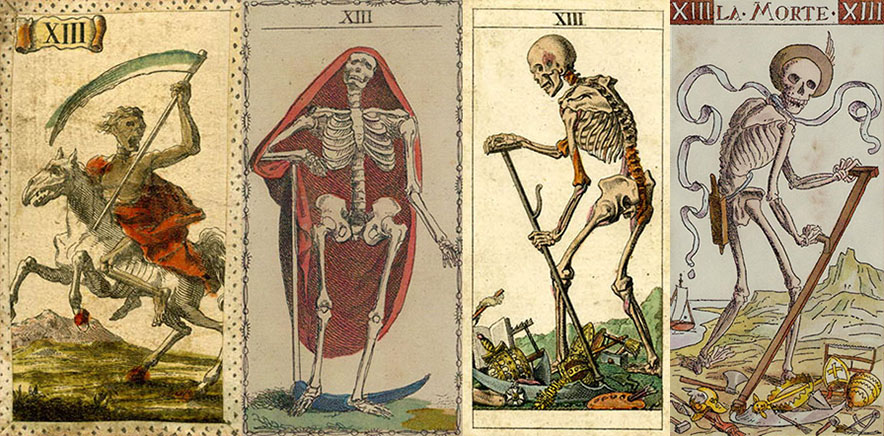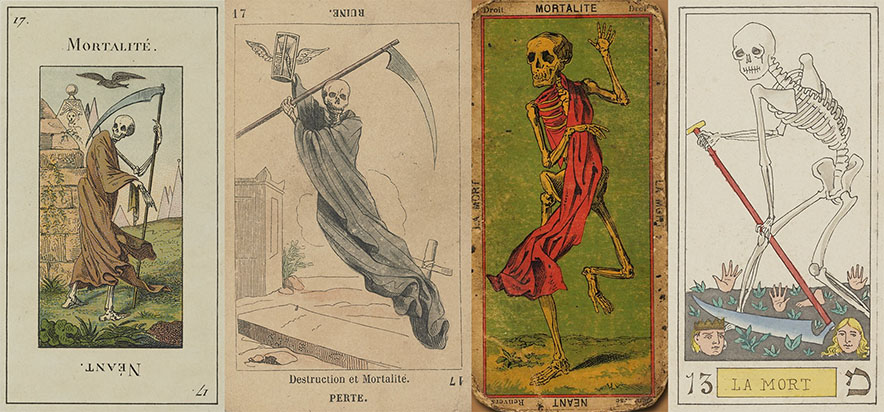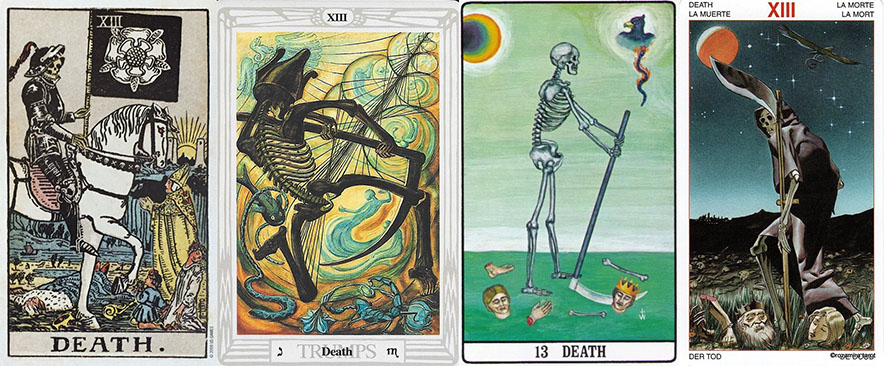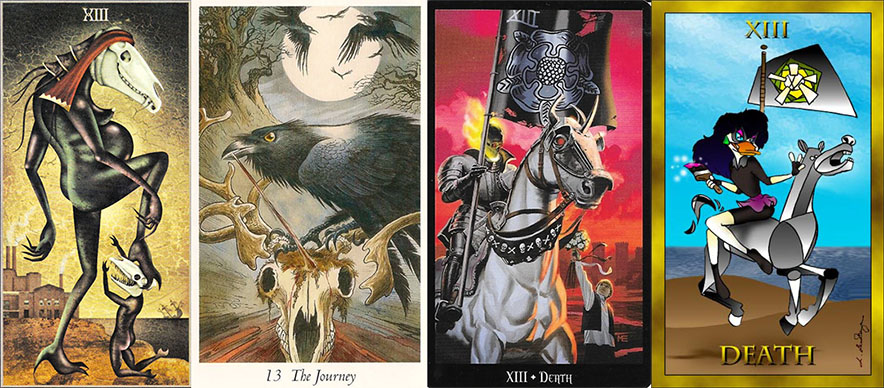THE TAROT WHEEL
LA MORTE - DEATH
If this card has been made to fear the children of a North Italian Ducal family, the artist certainly has reached his goal. The upper body of a skeleton man. The bones still covered with the pale grey remnants of the skin. The abdominal cavity is emptied of its content, the left and right parts of his chest fixed together with some rough stitches. On his head a white scarf, symbol the independence. Death has a horrible sneer on his face. Really, this is not a figure that you would like to cross on your path.
This card belongs to the so called Visconti di Modrone deck, also known as the Cary Yale Visconti. The deck has probably been created in 1441 for the occassion of the wedding between the condotierri Francesco Sforza and the daughther of the Milanese Duke, Bianca Maria Visconti. It is the oldest Trionfi deck we know and probably it had only 16 trump cards, of which 3 Virtues that we don't find on standard Tarot decks. Three Trionfi cards representing the allegory of Death survived, two created for the Ducal family of Milan and one for the Ducal family of Ferrara. They are shown here below.
Three representations of the allegory of Death. A skeleton covered by a pale skin, the abdominal area open and the inner organs removed. All three Death figures have the white scarf of independence on their skull. Three magnificent handpainted cards with a golden background, made for very wealthy North Italian Ducal families. As we saw above, the first card is from the so called Visconti di Modrone deck commissionned around 1441 by the Milanese Duke Filippo Maria Visconti. The second card is form the famous Visconti Sforza deck and was commissionned by the Milanese Duke Francesco Sforza (or his wife Bianca Maria Sforza) in the early fifties of the 15th Century, maybe in 1554 at the occassion of the peace treaty of Lodi, that marked the end of a long war between Venice and Milan. The third card is from the so called Charles VI deck probably commissionned by the Duke of Ferrara from the Este dinasty. The deck has been created somewhere in the second half of the 15th Century, probably somewhere between 1460 and 1480.
Two of the Skeletons are seated on a horse, this is a direct reference to the 4th Horseman of the book Revelation 6:7-8 in the Bible:
7 And when he had opened the fourth seal, I heard the voice of the fourth beast say, Come and see.
8 And I looked, and behold a pale horse: and his name that sat on him was Death
With his scythe he is harvesting the souls of everyone, independent of their social status or wealth. Under the horse we can distinguish a Pope, a King, Cardinals, everyone has to recognise Death as his final master. On the Visconti Sforza card we see a lone Death represented as an archer. This was in the Middle Ages also a quite common representation of Death, as a hunter of people.
Now let us see how contemporary printed decks represented Death.
All four cards shown here are from uncut sheets found in the binding of books that date around 1500. The first two cards are from sheets conserved in the Budapast Museum of Arts. Obviously they are from the same deck. The next card is from the Rosenwald sheet conserved in the National LiBrary of Arts in Washington. The last card is from the Rothschild sheet conserved in the Louvre in Paris. On all cards we see Death as the 4th Horseman, exactly as on the Visconti de Modrone and charles VI Trionfi decks. On the Budapest sheets the numbering follows the Ferrarese order of numbering, on the Rosenwald deck the Bolognese order, and on the Rothschild sheet there is no numbering. However the images on this sheet are identical to the standard Bolognese Tarocchino decks. Death is identical but mirrored with respect to the a Tarocchino deck. We remark that all four Death figures are seated on horses and hold a scythe in their hands, with the blade above their heads.
Apart from these standard representations of Death, It could be represented very different as we see here at the right. The first card is from the so called Mantegna Tarot, a wrong name because first the illustration has not been created by Mantegna and secondly it is not a Tarot deck. The Mantegna Tarot is a series of 50 illustrations created around 1465 that bring us, like in the Tarot, from the lowest ranking human (Misery) to a diagram of the Universe. Saturn is on the 47th position. He is the Roman God of death and rebirth. There was a prophesy that Saturn would be killed and replaced by one of his children, for this reason he ate them as soon as they were born. In his hand a scythe, used to harvest the crop, and as such a symbol of rebirth. The second card is from the so called Sola Busca deck, an extremely modern deck created in 1493 with illustrations on all pip cards. What complicates the interpretation of the trump cards from this deck is that all usual allegories have been replaced with Roman heroes and that the order of the cards has changed. Some of the cards are easy to associate, others are much more difficult.
Most people will associate Death with the card numbered XIII. Personnally I associate this card with the Star and I associate card numbered II with Death. Why? On the card we see a skull, a common representation of death. Postumio (Postumius) was a Roman leader who deserves to be associated with Death, as he killed his own son because he did not obey exactly his orders during a battle. And then there is his name. Postumius is very close to Postumus, a Latin word that means "after death". As such his name is a hint that life does not end with death and that rebirth is possible.
Before looking at further card images from the 16th Century and beyond, we will have a look at some 15th Century representations of Death in Art. Since the Black Death pandemie in the 14th Century, that killed one third of the European population, people had a lot of respect for Death, and this allegory was omnipresent in Europese Art of the late Middle Ages. Sometimes very subtle like in the two card images here above, but usually represented by a skeleton or decaying bodies. Death appeared in art in several popular themes that were repeated over and over again. Examples of these themes were the dance of death, the story of the three living and the three death and the triumph of death. Let us have a closer look at some representations of these three themes.
The Dance of Death presents itself as a series of images where Death is taking people with him, independent of their status or age. Here above we see in a French manuscript dating from the end of the 15th century Death taking a pope, an emperor, a peasant and a child. Nobody is safe, Death can take you at any moment. Death is presented here like on the Trionfi cards as a decaying corpse, often with the belly open and the remaining guts visible. Here below three other examples from another French manuscript from the same period, showing Death taking a queen, a peasant's wife and a fool.
The second theme about Death that is appearing many times in medieval and renaissance art is the story of the three living and the three death. The origins of this story go back to the end of the 13th Century. In this story three kings go on a hunting party. At a certain moment they loose the other members of their hunting party and they get lost in the woods. Then three figures appear that seems to be wandering death. The Kings are very frightened but the figures say they are not seeking to harm them. They speak the famous words "What you are now, we once were; what we are now, you shall be". An inscription with the same words can be found in the Santa Maria della Concezione dei Cappuccini, a church designed by a certain Antonio Casoni and build between 1626 and 1631 in Rome. In the crypt under this church you can observe the skeletons of 4000 Capuchin friars who died between 1500 and 1870. Here below some illustration of this story from 15th Century Italian and French Manuscripts.
A third theme about death that appears many times in late medieval and renaissance art is the Triumph of Death. This team is based on one of the six screnes described in the poem from Petrarch, I Triomfi, a 14th Century poem believed to be one of the main inspiration sources for the Trionfi cards, direct ancestors of the Tarot. In the poem only the Fool appears on a wagon, but on most illustrations that accompany the poem, all six trionfi are placed on a wagon. The wagon of the Triumph of Death is always drawn by to two brown or black oxen, like on the images here below. Death is carrying its traditional symbol the scythe.
Both illustrations here above are Italian. The left one is painted by a follower of Mantegna around 1460 and the right one appears in a manuscript that has been illustrated by Apollonia di Giovanni in 1442. The Triumph of Death has inspired painters for many years. Here below a fresco from an unknown artist painted around 1446 in Palermo, capital of Sicily.
This fresco is one of the inspiration sources for the famous Triumph of Death, painted a century later by Pieter Bruegel the Elder. The images of the Triumph of Death have many similarities with the Trionfi cards. A skeleton representing Death with a scythe or a bow, standing on a wagon or sitting on a horse with dead people below him from all ranks and social classes.
Now let us go back to the Tarot cards to see the development of this particular frightening card in France and in Italy. Let us first have a look at the French cards in the 16th and 17th Century.
The leftmost card has been created by Catelin Geoffroy in Lyon aroun 1557. In the 16th Century Lyon became the most important center of playing card production, and this included Tarot cards. The other three cards have all been produced in 17th Century Paris. The second card at the left has been made by an anonymous artist somewhere in the first half of the 17th Century. The second of the three cards from Paris was created by Jaques Vievil who was active as a card maker from 1643 to 1664. It is assumed that the cards have been created in the beginning of his active period. The third Paris card has been created by Jean Noblet who was according the records active from 1659 to 1681. Also here we assume that Jean Noblet created his Tarot deck in the very beginning of his active period. It is the oldest known card with the Tarot de Marseille pattern. All three Paris made cards have in common the same back, a hexagonal pattern. The four cards are quite similar with on all cards a skeleton with a scythe, and all of them facing left, to the past. Also in contrary with previous Italian cards, all cards are numbered and none of the Death figures is seated on a horse. Instead of having the scythe blade above their heads, now they are laboring the Earth, harvesting people's Souls. The anonymous Paris and the Noblet cards have their name written on the card, La Mort.
In Italy we have extremely few 16th Century Tarot cards left and none representing Death. In the 17th Century card making concentrated around Bologne and Florence. It is here that we find some variants of the Tarot, the Tarocchino and Minchiate decks. Also regular Tarot decks reappear here, but they all havel the French Tarot de Marseille as a model. Here below some Italian cards from this period.
At the left we see a standard Tarocchino card made in Bologna. On the 6 of Coins is mentionned "Carte fine dalla tore in Bologna", further there is no indication about the author or its year of creation. The second card is also a Tarocchino card, made in 1668 by Giuseppe Maria Mitelli in Bologna in order of Count Prospero Bentivoglio. Next a Minchate card made in Florence. On the back we see the blazon of the Florentine di Medici family. At the right a Tarocco card, also made in Bologna by Francesco Berti. All four cards date from the seventeenth Century. The first Tarocchino and the Minchiate cards have a typical Italian Death figure, with, like on the cards from the uncut sheets shown earlier on this page, Death riding a horse and holding the scythe in his hand with its blade above his head. Mitelli had an independent vision, so he draw a anatomically correct sceleton holding its traditional scythe and also an hourglass, symbolizing time. Life will come to its end when the last grain of sand falls down to the lower part of the hourglass. The Tarocco card has been made with the Tarot de Marseille as its model and is in design very similar to the Jean Noblet card. Like the 16th Century French cards, most Death figures are heading to the left, and none of them has its name printed on the card. Only the Mitelli skeleton is facing us directly as if he wants to tell us that he is waiting for our turn to come. Another feature we remark on some of these cards are the red dots and other background decorations. The main reason is that Italians disliked too much whitespace on the cards, so they filled this often with red dots or other patterns.
During much of the 18th Century Tarot cards produced in Europe will be based on the models designed in the 17th Century. There are improvements in the printing techniques and in the card design, but basically the model stays the same. Here below two Tarot of Marseille cards followed by German and Swiss cousins.
The first card is designed in 1713 by Jean-Pierre Payen in Lyon. It is a typical representative of the so called type I Tarot de Marseille. The second card is a type II Tarot de Marseille card, Designed by François Chosson and dated to 1736. The main difference between type I and type II cards is that Death is wearing some sort of skirt. On both cards the name is not appearing on this card. On most Tarot de Marseille cards the trump card representing Death has no name, with some rare exeptions (like Noblet). We remark that Death is now heading to the right, to the future, This to respect the fact that most Tarot de Marseille cards are mirrorred with respect to older cards. But exceptions there are. The third card is a Besançon type card, a Tarot type produced in German speaking countries based on the Tarot de Marseille but with some differences. One of the differences is that Death is facing again to the left. This particular deck has been created in 1760 by Andreas Benedictus Göbl in München (Germany). Although based on the Besançon style, the author redesignes every card. The poses are the same, but the figure comes out quite different on all trump cards. And so also Death. Remark that its name is mentionned and that the number appears twice on the top. The fourth card is an exception on an exception. All Besançon Death cards face left except some of them that were made in Switserland. The card shown here respects exactly the shape of the Death figure in other Besançon cards, but it faces right. This deck has been created by Bernard Schaer in 1784 in Soloturn. Switserland had many French influences and in 1784 the French Ambassador to Switserland was based in Soloturn, maybe this explains why this Swiss Besançon card follows here exactly the Tarot de Marseille.
Like we have seen with Giuseppe Mitelli, Italian cardmakers take a lot more freedom in their card design. And this did not change during the centuries as we can see here below.
The leftmost card is a 18th Century Fiorentine Minchiate card made by a unknown author. The design has developped a lot with respect to its 17th Century counterparts shown earlier. Next we see Death from the Tarot of Lombardy, created in 1810 by the Milanese cardmaker Ferdinand Gumppenberg and inspired by the conquest wars of Napoleon Bonaparte. The third card is designed by Carlo della Rocca and printed in 1815 on the same Gumppenberg printing press. The design is based on the Tarot de Marseille with much improved images. The last card is designed by Giovanni Vachetta in 1893 in the Turin region. This card also has some influences from the Tarot de Marseille; but as with the previous card, there are a lot of improvements with new details and symbols. Although the card designers are not limited by the exact copy of an existing model, they all keep the same theme, Death as a skeleton equiped with a scythe.
In the same period in France something else happened. In 1770 a French occultis called Jean-Baptiste Alliette published a book about card reading. He used the pseudonym Etteilla. In 1781 a French occultist called Court de Gebelin published a book in which he associated the Tarot with Egyptian hieroglypes. Etteilla embraced this Egytian origin of the tarot and between 1783 and 1785 he published a book in 4 volumes about divination with Tarot cards. In 1879 he published a Tarot deck himself that he called The Book of Thoth, because according to him the Tarot contained all ancient Egyptian wisdom. He 'corrected' the 'errors' that had slipped into the Tarot in eliminating some trumps, adding others, changing the order an in general redesigning the images. Death became in Eteilla's interpretation of the Tarot number 17.
In Etteilla's system the signification of the images was written on the card. For years cardmakers followed this model, presented as the only Tarot deck that could be used for divination. On the card as added symbols we see a black bird, representing a messenger of Death, and some Pyramids, emphasizing the Egyptian origin of the tarot. Most cardmakers stayed close to the original, others redesigned the cards at their turn. The second card dates from around 1845 and is called "Le Jeu de Princesses" (the princesses game). Here we sea a ghost like floating Death with a winged hourglass in his hand, symbolizing that our end is near. The third card, showing a dancing skeleton like on old medieval manuscripts, is from a deck called "Oracle des Dames" (a ladies oracle). It is also known as the Eteilla III.
The Egyptian origin of the Tarot was not adopted by all occultists. Some occultists (like the famous Elephas Levi) associated the Tarot with the Hebrew Kaballah and specifically with the Tree of Life where every trump card is associated with one of the 22 paths interconnecting the 10 nodes (Sephiroths) of the Tree of Life and with one of the 22 Hebrew characters associated with these paths. The fourth card is designed by a Swiss occultis working in France, Joseph Paul Oswald Wirth, who agreed with this Kaballa association. He returned to the Tarot de Marseille as a base concept, but added some occult symbolism, with among others on every card the corresponding Hebrew character. On all four cards we see that the basic symbol of the Death card, a skeleton, often with a scythe, stays unaltered.
At this point we are approaching the twentieth Century. The Tarot is discovered by the Golden Dawn society, a group of Anglo-Saxon occultist.They change the Tarot for their proper needs and the modern Tarot is born.
The first three decks have been created under guidance of a Golden Dawn member, the fourth one is inspirated on the Golden dawn tradition. The first deck is created by Pamela Colman Smith under instruction by Arthur Edward Waite. It was first published in 1909. Waite explained in detail how to read the cards in the book "A key to the Tarot". On the card a harnassed skeleton sitting on a white horse taking the lives of anyone on his path. In his hand a black flag with a white rose on it, representing change, transformation and spiritual growth. The second card is from a deck called the Book of Thoth, although it also show the corresponding Hebrew character. It is created by Lady Frieda Harris under guidance by Aleister Crowley, a very controversial occultist. The deck is conceived between 1938 and 1943 and first published in 1944 in a 200 copy limited edition, accompanied by a book of the same name. But we have to wait until 1969 before the deck is printed. The deck, in bright colors and with a very complicated symbolism is a success and it has a great influence on many later Tarot deck makers. The third deck is created by the illustrator Robert Wang under guidance of the Golden Dawn member Israel Regardie, one on the most influential occultists of modern times. The cards are based on the esoteric notebooks of Samuel Liddell MacGregor Mathers, founder of the Golden Dawn society. Concerning the card Death Mathers wrote in 1888 in his note book "A skeleton armed with a Scythe (wherewith he mows down heads in a meadow like grass). He signifies Transformation, or Change". The fourt card is from a deck called "Initiatory Tarot of the Golden Dawn" illustrated in 2008 by Patrizio Evangelisti under the guidance of Giordano Berti and Andrea Chiarvesio and also inspired by the same notebooks of Mathers. Giordano Berti is from Bologna and belongs to an old card makers family.
Modern Tarot decks can roughly be devided in 3 types. We have Tarot decks for game playing, surviving in France with French suit signs and in Italy with Italian suit signs. They are double headed like standard bridge and poker cards. The second group are the collectibles, close reproductions of older decks. The third group consist of the divinatory Tarot decks. There are special designed for divination and often designed with a certain theme in mind. In many cases they are based in order and symbolism on the Smith/Waite or the Harris/Crowley deck, but always. There is no strict separation, collectibles and standard playing cards can be used for divination, especially the Tarot de Marseille decks are often used for this purpose. Here under four 'random' examples of modern Death cards.
From left to right we have the Deviant Moon Tarot, created in 2008 by Patrick Valenza, the Wildwood Tarot, created in 2010 by John Matthews and Mark Ryan and illustrated by Will Worthington, the Witches Tarot, created in 2012 by Ellen Dugan and digitally illustrated by Mark Evans and finally the Disney Afternoon Tarot, created by Lar and unfortunately not published. In these images we are very far from the original skeleton with his scythe, although in the two rightmost images we see clearly the Waite/Smith deck as an inspiration source. Symbolism can be quite different from the older decks we know, so every new Tarot deck is speaking to a particular audience.
Here we end our journey through the ages accompanied by the Death card. The symbolism of the card has little changed, Death is the end, our time is up. And our vision of Death did not change over the Centuries. Everybody knows it cannot be avoided, and many people are afraid from the process off dying or fear that everything will end when we die. However, in the Tarot Death is only card number 13 out of 21, so here it is clear that Death is not the end. Death stands for purification, change, transition to another situation. In this the card is not so negative as it looks, important changes are in view and it is up to us to take the opportunity and become better through this process of change.
